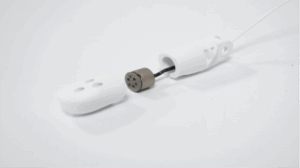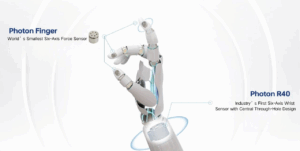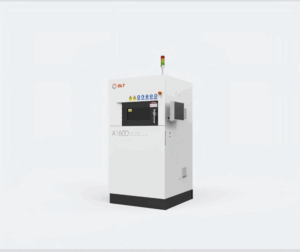Accelerating Robotic Sensing: BLT and Haptron Scientific Co-Engineer Next-Gen Optical Force Sensors
As humanoid robotics and embodied intelligence technologies rapidly advance toward industrial-scale deployment, high-performance force sensing plays a critical role in enabling compliant control, precise manipulation, and robust mobility over complex terrains.
Six-axis force/torque sensors have become essential components for safe and adaptive human-robot interaction.
Since 2024, Haptron Scientific and Bright Laser Technologies (BLT) have collaborated to develop a new generation of optical six-axis force sensors.
By integrating Haptron Scientific’s proprietary optical multimodal sensing technology with BLT’s expertise in metal additive manufacturing, the partnership has delivered a comprehensive sensor suite—including the Photon Finger, PhotonR40, Photon Ankle, and the latest industrial-grade Photon Finger Max—targeting force measurement needs at key robotic joints such as fingers, wrists, and ankles.
 By utilising BLT’s metal 3D printing technology, Haptron Scientific break traditional manufacturing limits, enabling complex miniaturized designs with fewer parts and simpler assembly.
By utilising BLT’s metal 3D printing technology, Haptron Scientific break traditional manufacturing limits, enabling complex miniaturized designs with fewer parts and simpler assembly.
This innovation supports scalable production while delivering precise, durable, and lightweight force sensors for next-gen humanoid robots—enabling safer, more dexterous, and versatile robotic platforms.
Photon Finger: World’s Smallest Six-Axis Force Sensor
Designing dexterous hands for humanoid robots presents unique challenges—especially at the finger joints, where space is extremely constrained. These tight dimensions demand compact, high-performance sensors with seamless integration.
To address the limitations of traditional machining—such as high cost, long lead times, and low yield—Haptron Scientific developed the world’s smallest six-axis force/torque sensor, the Photon Finger, using its proprietary optical multimodal sensing technology.
With the support of BLT’s PBF-LB/M BLT-A100 machine and high-performance 18Ni350 maraging steel powder, the Photon Finger was structurally optimised for integration and part count reduction through one-piece metal 3D printing. This enabled:
- Miniaturised design tailored for tight finger joint integration
- 20-minute batch production cycle, with 15–30 units printed simultaneously
- 50–250% improvements in force range and overload tolerance
- Improved signal integrity, lower in-use power consumption, and faster communication—ideal for rapid system integration and iteration
Now recognised as a new industry benchmark in miniaturized force sensing, the Photon Finger empowers humanoid robots with advanced capabilities in grasp control, material compliance detection, and beyond.
PhotonR40: Industry’s First Six-Axis Wrist Sensor with Central Through-Hole Design
The wrist joint plays a crucial role in enabling humanoid robots to perform tasks. A lighter six-axis force/torque sensor at the wrist can greatly enhance a robot’s flexibility, agility, task efficiency, and battery life.
In December 2024, Haptron Scientific launched the PhotonR40—a high-performance six-axis force/torque sensor with a central through-hole structure—specifically designed to simplify force sensing integration in humanoid robot wrists.
BLT supported the mass production of the PhotonR40’s core structure using lightweight materials, achieving a 20–30% reduction in weight while improving overall sensor performance. This, in turn, enhances the robot’s stability and balance. In addition, BLT’s metal 3D printing technology enabled the one-piece fabrication of complex internal geometries, reducing assembly complexity and significantly increasing production efficiency.
Ankle Joint Sensor: Built for High-Strength, Dynamic Applications
The six-axis force sensor for the ankle joint is a critical component used to measure force and torque during walking, standing, and other human motions. It requires exceptional strength, overload capacity, and long-term reliability. Leveraging BLT’s advanced metal 3D printing process and high-strength, cost-effective steel materials, Haptron Scientific has achieved a breakthrough in the development of this sensor. Through structural optimization, the sensor now demonstrates significantly enhanced performance:
- Load capacity increased to 8000N / 500N·m
- Yield strength reaches 2400 MPa, greatly improving resistance to deformation
- Overload capacity enhanced to 300%, significantly boosting overall reliability
These improvements provide robust support for stable operation in robotic applications.
Latest Breakthrough – Photon Finger Max: 700N Load Capacity for Wider Industrial Use
The second-generation optical-based multi-axis force sensor, featuring a compact 9.5 mm diameter form factor, is engineered for seamless integration into robotic fingertips and end-effectors. Leveraging BLT’s high-resolution BLT-A160 PBF-LB/M machine and 18Ni300 maraging steel powder, the sensor’s elastic structures have been topology-optimized for superior mechanical performance, achieving a 23× increase in load capacity—up to 700 N—over the previous generation.
The sensor passed high-frequency, high-load testing, while the refined assembly interfaces streamline integration and accelerate iterative development for robotic applications.
Photon Finger Max
From lightweight human-robot interaction in domestic service robots to mid-to-high force tasks in industrial automation, the expanded measurement range enables the sensor to meet a broader spectrum of application scenarios.
05 / Accelerating the Robotics Industry: Scalable and Agile Production with Additive Manufacturing
Throughout the collaboration, metal additive manufacturing demonstrated exceptional adaptability and industrial scalability:
- Design Flexibility: Enables complex geometries with internal channels, fine features, and high degrees of freedom.
- Accelerated Delivery: Significantly shortened production cycles and enhanced batch manufacturing efficiency.
- Consistent Performance: Ensures reliable and repeatable mechanical properties.
- Cost Efficiency: Reduces material waste and processing steps, delivering a more cost-effective solution.
These capabilities make AM a powerful enabler for the evolving needs of the robotics industry, from prototyping to mass production.
BLT-A160
With over a decade of expertise in metal 3D printing, BLT helped Haptron Scientific break new ground by meeting its need for smaller, stronger, and lighter components—setting a new benchmark for tactile sensing systems in humanoid robots. From fingertip-level micro-force sensing to high-load industrial sensors, the two companies are jointly advancing sensor manufacturing toward greater intelligence, scalability, and standardisation.
Looking ahead, BLT and Haptron Scientific will continue to explore cutting-edge applications in robotics, additive manufacturing, and new materials—accelerating the path toward smarter, more autonomous manufacturing.





